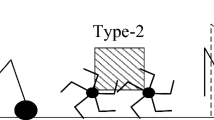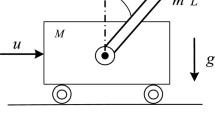Abstract
This paper offers a new push recovery method to stabilize the quadruped robots walking on even terrains in the presence of external disturbance forces exerted on the body and legs of the robot. To avoid force sensors, a class of nonlinear observers is usually used to estimate all the forces that are applied to the leg joints. However, such estimations involve permanent errors in the case of fast varying external forces. A new sliding-mode control method is designed to enable the robot to track a desired gait with high precision despite the persisting estimation error of the original nonlinear disturbance observer. A new push recovery method that uses the estimations of the disturbance observer is proposed to help the robot maintain its balance in the presence of sudden external forces applied to the robot legs and body. To this end, an optimization problem is proposed to calculate the optimized accelerations of the leg joints of the robot. This controller was applied to the TMUBot quadruped robot as a case study to verify the effectiveness of the design. Moreover, unlike other similar works, which use massless model of the legs, the masses of the legs of the quadruped are considered in this work. As such, the dynamic equations of the legs have also been considered throughout the proposed design method.
























Similar content being viewed by others
References
Aftab Z, Robert T, Wieber PB (2012), Ankle, hip and stepping strategies for humanoid balance recovery with a single model predictive control scheme. In: Proceedings of IEEE-RAS international conference on humanoid robots, Osaka, Japan, pp 159–164
Attar M, Majd VJ, Dini N, Edrisi F (2016) Estimation of decentralized unknown dynamics for a 2DOF manipulator using a time varying extended state observer. In: Proceedings of the 4th RSI international conference on robotics and mechatronics (ICRoM), Tehran, Iran, pp 116–121
Attar M, Majd VJ, Dini N (2019) Analysis and design of a time-varying extended state observer for a class of nonlinear systems with unknown dynamics using spectral Lyapunov function. J Intell Robot Syst 94(2):405–421
Barasuol V, Buchli J, Semini C, Frigerio M, De Pieri ER, Caldwell DG (2013) A reactive controller framework for quadrupedal locomotion on challenging terrain. In: IEEE international conference on: robotics and automation (ICRA), Karlsruhe, Germany, pp 2554–2561
Bazara MS, Sherali HD, Shetty CM (1993) Nonlinear programming—theory and algorithms, 2nd edn. Wiley, New York
Bledt G, Powell MJ, Katz B, Carlo JD, Wensing PM, Kim S (2018) MIT cheetah 3: design and control of a robust, dynamic quadruped robot. In: 2018 IEEE/RSJ international conference on intelligent robots and systems (IROS), Madrid, Spain
Chen WH, Ballance DJ, Gawthrop PJ, O’Reily J (2000) A nonlinear disturbance observer for robotic manipulators. IEEE Trans Ind Electron 4:932–938
Chen WH, Yang J, Guo L, Li S (2016) Disturbance-observer-based control and related methods—an overview. IEEE Trans Ind Electron 63(2):1083–1095
Chung JW, Lee IH, Cho BK, Oh JH (2013) Posture stabilization strategy for a trotting point-foot quadruped robot. J Intell Robot Syst 72(3):325–341
Dini N, Majd VJ, Edrisi F, Attar M (2016) Estimation of external forces acting on the legs of a quadruped robot using two nonlinear disturbance observers. In: Proceedings of the 4th RSI international conference on robotics and mechatronics (ICRoM), Tehran, Iran, pp 72–77
Farid Y, Majd VJ, Seresht AE (2018) Fractional-order active fault-tolerant force-position controller design for the legged robots using saturated actuator with unknown bias and gain degradation. Mech Syst Signal Process 104(1):465–486
Ghafarirad H, Rezaei SM, Zareinejad M, Sarhan AAD (2014) Disturbance rejection-based robust control for micropositioning of piezoelectric actuators. C R Mec 342:32–45
Gonzalez de Santos P, Garcia E, Estremera J (2007) Quadrupedal locomotion: an introduction to the control of four-legged robots. Springer, Madrid
Gueaieb W, Karray F, Al-Sharhan S (2007) A robust hybrid intelligent position/force control scheme for cooperative manipulators. IEEE/ASME Trans Mech 2(12):109–125
Havoutis I, Semini C, Buchli J, Caldwell DG (2013) Quadrupedal trotting with active compliance. In: Proceedings of IEEE international conference on mechatronics, IEEE, Vicenza, Italy, pp 610–616
Huang H, Sun D, Mills JK, Li WJ (2007) Visual-based impedance control of three-dimensional cell injection system. In: IEEE international conference on robotics and automation, Roma, Italy, pp. 4196–4210
Khorram M, Moosavian SAA (2016) Push recovery of a quadruped robot on challenging terrains. Robotica 35(8):1–20
Kim YJ, Lee JY, Lee JJ (2016) A force-resisting balance control strategy for a walking biped robot under an unknown. Contin Force Robot 34(7):1495–1516
Li Z, Ge ShS, Liu S (2013) Contact-force distribution optimization and control for quadruped robots using gradient and adaptive neural networks. IEEE Trans Neural Netw Learn Syst 28(8):1460–1473
Li Z, Xiao S, Ge SS, Su H (2016) Constrained multilegged robot system modeling and fuzzy control with uncertain kinematics and dynamics incorporating foot force optimization. IEEE Trans Syst Man Cybern Syst 46(1):1–15
Liu CS, Peng H (1997) Disturbance observer based tracking control. ASME Trans Dyn Syst Meas Control 122(2):332–335
Mohammadi A, Tavakoli M, Marquez HJ, Hashemzadeh F (2013) Nonlinear disturbance observer design for robotic manipulators. Control Eng Pract 21(3):253–267
Naf D (2011) Quadruped walking/running simulation. Master’s Thesis, Swiss Federal Institute of Technology (ETH), Zurich, Spring Term
Nikoobin A, Haghighi R (2009) Lyapunov-Based Nonlinear Disturbance Observer for Serial n-link Robot Manipulators. J Intell Rob Syst 55(2–3):135–153
Ning D, Sun S, Zhang F, Du H, Li W, Zhang B (2017) Disturbance observer based Takagi-Sugeno fuzzy control for an active seat suspension. Mech Syst Signal Process 93:515–530
Ohba Y, Katsura S, Ohishi K (2006) Sensor-less force control for machine tool using reaction torque observer. In: IEEE international conference on industrial technology, Mumbai, India, pp 860–865
Parhald V, Dip G, Meng-Hwee C (2008) Disturbance rejection by online ZMP compensation. Robotica 26(1):9–17
Payandeh S, Majd VJ, Shoili SM, Moghadam MM (2014) Improving the stability of gait planning for quadruped robots. In: The 2nd RSI international conference on robotics and mechatronics (ICRoM), Tehran, Iran, pp 382–387
Sanjurjo E, Dopico D, Luaces A, Naya MA (2018) State and force observers based on multibody models and the indirect Kalman filter. Mech Syst Signal Process 106:210–228
Sastry S, Bodson M (1989) Adaptive control—stability, convergence, and robustness. Prentice-Hall, Englewood Cliffs
Shi Z, Li Y, Liu G (2017) Adaptive torque estimation of robot joint with harmonic drive transmission. Mech Syst Signal Process 96:1–15
Silva M, Barbosa R, Castro T (2013) Multi-legged walking robot modelling in MATLAB/Simmechanics TM and its simulation. In: 8th EUROSIM congress on modelling and simulation, Cardiff, UK, pp 226–231
Wensing PM, Wang A, Seok S, Otten D, Lang J, Kim S (2017) Proprioceptive actuator design in the MIT Cheetah: impact mitigation and high-bandwidth physical interaction for dynamic legged robots. IEEE Trans Robot 33(3):509–522
Author information
Authors and Affiliations
Corresponding author
Rights and permissions
About this article
Cite this article
Dini, N., Majd, V.J. Sliding-Mode Tracking Control of a Walking Quadruped Robot with a Push Recovery Algorithm Using a Nonlinear Disturbance Observer as a Virtual Force Sensor. Iran J Sci Technol Trans Electr Eng 44, 1033–1057 (2020). https://doi.org/10.1007/s40998-019-00283-7
Received:
Accepted:
Published:
Issue Date:
DOI: https://doi.org/10.1007/s40998-019-00283-7




